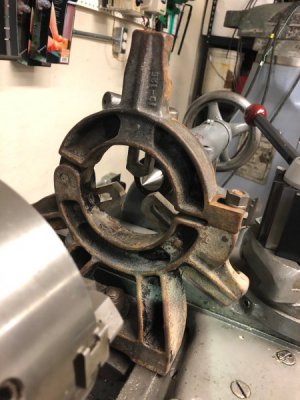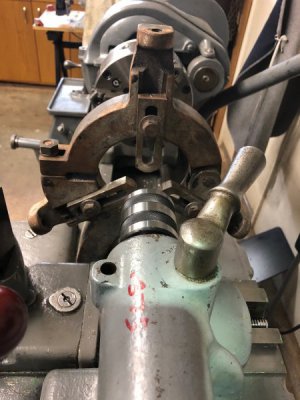-
Welcome back Guest! Did you know you can mentor other members here at H-M? If not, please check out our Relaunch of Hobby Machinist Mentoring Program!
You are using an out of date browser. It may not display this or other websites correctly.
You should upgrade or use an alternative browser.
You should upgrade or use an alternative browser.
Need Help With my SB 13 Steady Rest
- Thread starter Janderso
- Start date
South Bend sold that design for decades, thousands of machinists have used it over the years.
Use it. If you find a job where the steel tips are marking up your part to an unacceptable level then figure out a way to make soft tips.
Til then run what ya brung.
Use it. If you find a job where the steel tips are marking up your part to an unacceptable level then figure out a way to make soft tips.
Til then run what ya brung.
- Joined
- Nov 5, 2016
- Messages
- 1,419
I have a steady similar to yours on my SB15. I believe my "fingers" are made out of cast iron and would suspect that yours are as well. That is of course if they are original. CI is a very good bearing material for running steel shafts as long as it is lubricated. My steady works fine. I suggest you try it and I'll bet you get very satisfactory results with it just the way it is.
Ted
Ted
- Joined
- Mar 26, 2018
- Messages
- 8,386
Hey Ted,
The fingers are original but I will make some knurled hand tightening knobs to replace the grade 5 hardware bolts that came with it. In pics of these properly equipped they have the knurled adjusters I speak of, in addition to various soft jaws. I am thinking black oxide screws with the pinned knurled adjusters. Hey, I need projects to improve my skills.
Cast iron, yes probably. I think I will give it a go. I need to clean it up and paint it first, I do like the bearing idea also.
My OCD will not allow otherwise.
Swarf, ya, that would be ugly.
The fingers are original but I will make some knurled hand tightening knobs to replace the grade 5 hardware bolts that came with it. In pics of these properly equipped they have the knurled adjusters I speak of, in addition to various soft jaws. I am thinking black oxide screws with the pinned knurled adjusters. Hey, I need projects to improve my skills.
Cast iron, yes probably. I think I will give it a go. I need to clean it up and paint it first, I do like the bearing idea also.
My OCD will not allow otherwise.
Swarf, ya, that would be ugly.
- Joined
- Nov 5, 2016
- Messages
- 1,419
If you have a critical application where you're worried about chips running under the bearings you can easily make up a cardboard guard with duct tape (or whatever) to protect things. We had a steady with roller bearings at a place I used to work and found that roller bearings can capture crud easier than non roller type bearings, because the wheels can suck in chips easier than they can get sucked in with the minimal clearance of a non roller type bearing surface. Even though oil or other lubricant can make chips stick they usually, will just lay between the bearing and workpiece waiting to be cleaned off when you stop between cuts. The clearance is so small it's hard for things to work their way in, but the wheels will grab stuff, put it under are easily roll over it. Using wheels, make sure you keep your rags, etc.. well away!
Typically, you'll get a mark on the workpiece anyways with either type of bearing just because of the contact. A lot depends on how much you actually run the part in the steady. Only putting a center in the end of a shaft doesn't take long, but doing extended operations on a workpiece is another story.
I'm sure others have different experiences and that's fine... that's why we post here to share ideas and experiences.
Like most things, what is better or best "depends" on a million different variables. Experience helps immensely, but we always have more to learn!
Ted
Typically, you'll get a mark on the workpiece anyways with either type of bearing just because of the contact. A lot depends on how much you actually run the part in the steady. Only putting a center in the end of a shaft doesn't take long, but doing extended operations on a workpiece is another story.
I'm sure others have different experiences and that's fine... that's why we post here to share ideas and experiences.
Like most things, what is better or best "depends" on a million different variables. Experience helps immensely, but we always have more to learn!
Ted
- Joined
- Mar 26, 2018
- Messages
- 8,386
Ted, I think you bring up some very good points I had never considered.
Each application, duration of time exposed all bring up options.
That's the beauty of experience. In my case I have none with regard to a steady rest.
Yes, this is a great forum. It seems all participants are treated with respect and this forum covers all skill levels.
Each application, duration of time exposed all bring up options.
That's the beauty of experience. In my case I have none with regard to a steady rest.
Yes, this is a great forum. It seems all participants are treated with respect and this forum covers all skill levels.
- Joined
- Nov 5, 2016
- Messages
- 1,419
A very important safety measure came to mind. When putting a workpiece in a steady, make sure that the bearing surface where the steady is riding is running in the same axis as the lathe's center! If not, the workpiece can kind of "screw" its' way out of the chuck, and that is NOT a good thing!
So, to exaggerate things a little to make it easier to visualize, if you have the steady setup 1/2" too low (so the workpiece's end on the tailstock side is running 1/2" lower than the spindle axis of the lathe) every revolution of the spindle the work piece will creep out of the chuck a little bit. This situation will also cause you to bore and/or turn a taper, but that's just a size issue where coming out of the chuck is a huge safety issue!
This happens when the workpiece is ridgid enough that it does not flex. If the workpiece is slender it may just flex before working it's way out of the chuck, but regardless, line things up the best you can and measure how far the piece is in the chuck so you can check it from time to time to make sure it's staying put.
I have had parts start to move out on me, but luckily I caught it before it was too late. I know that is has happened though to some of the guys I used to work with.
Ted
So, to exaggerate things a little to make it easier to visualize, if you have the steady setup 1/2" too low (so the workpiece's end on the tailstock side is running 1/2" lower than the spindle axis of the lathe) every revolution of the spindle the work piece will creep out of the chuck a little bit. This situation will also cause you to bore and/or turn a taper, but that's just a size issue where coming out of the chuck is a huge safety issue!
This happens when the workpiece is ridgid enough that it does not flex. If the workpiece is slender it may just flex before working it's way out of the chuck, but regardless, line things up the best you can and measure how far the piece is in the chuck so you can check it from time to time to make sure it's staying put.
I have had parts start to move out on me, but luckily I caught it before it was too late. I know that is has happened though to some of the guys I used to work with.
Ted



